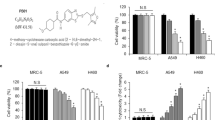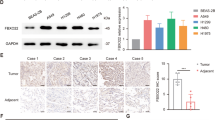Abstract
FUS1 is a novel tumor suppressor gene located in the human chromosome 3p21.3 region. We previously showed that restoration of FUS1 function in 3p21.3-deficient human non-small-cell lung cancer (NSCLC) cells significantly inhibited tumor cell growth in vitro and in vivo. In this study, we evaluated the combined effects of the tumor suppressor FUS1 and the chemotherapeutic drug cisplatin on tumor cell growth and apoptosis induction in NSCLC cells, and explored the molecular mechanism of their mutual action. Exogenous expression of FUS1 by nanoparticle-mediated gene transfer sensitized the response of NSCLC cells to cisplatin, resulting in a 4- to 6-fold increase in tumor-suppressing activity. A systemic treatment with a combination of FUS1-nanoparticles and cisplatin in a human H322 lung cancer orthotopic xenograft mouse model dramatically enhanced the therapeutic efficacy of cisplatin. We also found that the FUS1-enhanced chemosensitivity is associated with the downregulation of MDM2, accumulation of p53 and activation of the Apaf-1-dependent apoptosis pathway. Our results demonstrated an important role of FUS1 in modulating chemosensitivity of lung cancer cells, and suggested that a proper combination of molecular therapeutics such as the proapoptotic tumor suppressor FUS1 and the conventional chemotherapeutic drugs such as cisplatin may be an efficient treatment strategy for human lung cancer.
This is a preview of subscription content, access via your institution
Access options
Subscribe to this journal
Receive 12 print issues and online access
$259.00 per year
only $21.58 per issue
Buy this article
- Purchase on Springer Link
- Instant access to full article PDF
Prices may be subject to local taxes which are calculated during checkout




Similar content being viewed by others
References
Jemal A, Murray T, Ward E, Samuels A, Tiwari RC, Ghafoor A et al. Cancer statistics. CA Cancer J Clin 2005; 55: 10–30.
Stevens CW, Lee JS, Cox J, Komaki R . Novel approaches to locally advanced unresectable non-small cell lung cancer. Radiother Oncol 2000; 55: 11–18.
El Sherif A, Luketich JD, Landreneau RJ, Fernando HC . New therapeutic approaches for early stage non-small cell lung cancer. Surg Oncol 2005; 14: 27–32.
Pritchard RS, Anthony SP . Chemotherapy plus radiotherapy compared with radiotherapy alone in the treatment of locally advanced, unresectable, non-small-cell lung cancer—a meta-analysis. Ann Intern Med 1996; 125: 723–729.
Raben D, Helfrich B, Chan DC, Ciardiello F, Zhao L, Franklin W et al. The effects of cetuximab alone and in combination with radiation and/or chemotherapy in lung cancer. Clin Cancer Res 2005; 11: 795–805.
Baruah H, Barry CG, Bierbach U . Platinum-intercalator conjugates: from DNA-targeted cisplatin derivatives to adenine binding complexes as potential modulators of gene regulation. Curr Top Med Chem 2004; 4: 1537–1549.
Ornstein DL, Nervi AM, Rigas JR . Docetaxel (Taxotere) in combination chemotherapy and in association with thoracic radiotherapy for the treatment of non-small-cell lung cancer. Ann Oncol 1999; 10 (Suppl 5): S35–S40.
Cohen SM, Lippard SJ . Cisplatin: from DNA damage to cancer chemotherapy. Prog Nucleic Acid Res Mol Biol 2001; 67: 93–130.
Wistuba II, Behrens C, Virmani AK, Mele G, Milchgrub S, Girard L et al. High resolution chromosome 3p allelotyping of human lung cancer and preneoplastic/preinvasive bronchial epithelium reveals multiple, discontinuous sites of 3p allele loss and three regions of frequent breakpoints. Cancer Res 2000; 60: 1949–1960.
Zochbauer-Muller S, Gazdar AF, Minna JD . Molecular pathogenesis of lung cancer. Annu Rev Physiol 2002; 64: 681–708.
Lerman MI, Minna JD . The 630-kb lung cancer homozygous deletion region on human chromosome 3p21.3: identification and evaluation of the resident candidate tumor suppressor genes. The International Lung Cancer Chromosome 3p21.3 Tumor Suppressor Gene Consortium. Cancer Res 2000; 60: 6116–6133.
Zabarovsky ER, Lerman MI, Minna JD . Tumor suppressor genes on chromosome 3p involved in the pathogenesis of lung and other cancers. Oncogene 2002; 21: 6915–6935.
Ji L, Nishizaki M, Gao B, Burbee D, Kondo M, Kamibayashi C et al. Expression of several genes in the human chromosome 3p21.3 homozygous deletion region by an adenovirus vector results in tumor suppressor activities in vitro and in vivo. Cancer Res 2002; 62: 2715–2720.
Kondo M, Ji L, Kamibayashi C, Tomizawa Y, Randle D, Sekido Y et al. Overexpression of candidate tumor suppressor gene FUS1 isolated from the 3p21.3 homozygous deletion region leads to G1 arrest and growth inhibition of lung cancer cells. Oncogene 2001; 20: 6258–6262.
Uno F, Sasaki J, Nishizaki M, Carboni G, Xu K, Atkinson EN et al. Myristoylation of the FUS1 protein is required for tumor suppression in human lung cancer cells. Cancer Res 2004; 64: 2969–2976.
Ito I, Ji L, Tanaka F, Saito Y, Gopalan B, Branch CD et al. Liposomal vector mediated delivery of the 3p FUS1 gene demonstrates potent antitumor activity against human lung cancer in vivo. Cancer Gene Ther 2004; 11: 733–739.
Roth JA, Grammer SF . Gene replacement therapy for non-small cell lung cancer: a review. Hematol Oncol Clin North Am 2004; 18: 215–229.
Fang B, Roth JA . Adenovirus-mediated cancer gene therapy. In: Hunt K (ed). Gene Therapy for Cancer. Humana Press: Totowa, NJ, 2005.
Horio Y, Hasegawa Y, Sekido Y, Takahashi M, Roth JA, Shimokata K . Synergistic effects of adenovirus expressing wild-type p53 on chemosensitivity of non-small cell lung cancer cells. Cancer Gene Ther 2000; 7: 537–544.
Nishizaki M, Fujiwara T, Tanida T, Hizuta A, Nishimori H, Tokino T et al. Recombinant adenovirus expressing wild-type p53 is antiangiogenic: a proposed mechanism for bystander effects. Clin Cancer Res 1999; 5: 1015–1023.
Spitz FR, Nguyen D, Skibber JM, Meyn RE, Cristiano RJ, Roth JA . Adenoviral-mediated wild-type p53 gene expression sensitizes colorectal cancer cells to ionizing radiation. Clin Cancer Res 1996; 2: 1665–1671.
Fujiwara T, Grimm EA, Mukhopadhyay T, Zhang WW, Owen-Schaub LB, Roth JA . Induction of chemosensitivity in human lung cancer cells in vivo by adenoviral-mediated transfer of the wild-type p53 gene. Cancer Res 1994; 54: 2287–2291.
Nishizaki M, Meyn RE, Levy LB, Atkinson EN, White RA, Roth JA et al. Synergistic inhibition of human lung cancer cell growth by adenovirus-mediated wild-type p53 gene transfer in combination with docetaxel and radiation therapeutics in vitro and in vivo. Clin Cancer Res 2001; 7: 2887–2897.
Ueda K, Kawashima H, Ohtani S, Deng WG, Ravoori M, Bankson J et al. The 3p21.3 tumor suppressor NPRL2 plays an important role in cisplatin-induced resistance in human NSCLC cells. Cancer Res 2006; 66: 9682–9690.
Lowe SW, Ruley HE, Jacks T, Housman DE . p53-dependent apoptosis modulates the cytotoxicity of anticancer agents. Cell 1993; 74: 957–967.
Liu JR, Opipari AW, Tan L, Jiang Y, Zhang Y, Tang H et al. Dysfunctional apoptosome activation in ovarian cancer: implications for chemoresistance. Cancer Res 2002; 62: 924–931.
Hickman JA . Apoptosis and chemotherapy resistance. Eur J Cancer 1996; 32A: 921–926.
Cho HJ, Kim JK, Kim KD, Yoon HK, Cho MY, Park YP et al. Upregulation of Bcl-2 is associated with cisplatin-resistance via inhibition of Bax translocation in human bladder cancer cells. Cancer Lett 2006; 237: 56–66.
Siddik ZH . Cisplatin: mode of cytotoxic action and molecular basis of resistance. Oncogene 2003; 22: 7265–7279.
Segal-Bendirdjian E, Mannone L, Jacquemin-Sablon A . Alteration in p53 pathway and defect in apoptosis contribute independently to cisplatin-resistance. Cell Death Differ 1998; 5: 390–400.
Gallagher WM, Cairney M, Schott B, Gallagher WM, Cairney M, Schott B et al. Identification of p53 genetic suppressor elements which confer resistance to cisplatin. Oncogene 1997; 14: 185–193.
Niedner H, Christen R, Lin X, Kondo A, Howell SB . Identification of genes that mediate sensitivity to cisplatin. Mol Pharmacol 2001; 60: 1153–1160.
Park SA, Park HJ, Lee BI, Ahn YH, Kim SU, Choi KS . Bcl-2 blocks cisplatin-induced apoptosis by suppression of ERK-mediated p53 accumulation in B104 cells. Brain Res Mol Brain Res 2001; 93: 18–26.
Ashcroft M, Vousden KH . Regulation of p53 stability. Oncogene 1999; 18: 7637–7643.
Juven-Gershon T, Oren M . Mdm2: the ups and downs. Mol Med 1999; 5: 71–83.
Lahav G, Rosenfeld N, Sigal A, Geva-Zatorsky N, Levine AJ, Elowitz MB et al. Dynamics of the p53-Mdm2 feedback loop in individual cells. Nat Genet 2004; 36: 147–150.
Prives C . Signaling to p53: breaking the MDM2–p53 circuit. Cell 1998; 95: 5–8.
Freedman DA, Epstein CB, Roth JC, Levine AJ . A genetic approach to mapping the p53 binding site in the MDM2 protein. Mol Med 1997; 3: 248–259.
Chen L, Agrawal S, Zhou W, Zhang R, Chen J . Synergistic activation of p53 by inhibition of MDM2 expression and DNA damage. Proc Natl Acad Sci USA 1998; 95: 195–200.
Kubbutat MH, Jones SN, Vousden KH . Regulation of p53 stability by Mdm2. Nature 1997; 387: 299–303.
Moroni MC, Hickman ES, Lazzerini Denchi E, Caprara G, Colli E, Cecconi F et al. Apaf-1 is a transcriptional target for E2F and p53. Nat Cell Biol 2001; 3: 552–558.
Hickman ES, Helin K . The regulation of APAF1 expression during development and tumourigenesis. Apoptosis 2002; 7: 167–171.
Fortin A, Cregan SP, MacLaurin JG, Kushwaha N, Hickman ES, Thompson CS et al. APAF1 is a key transcriptional target for p53 in the regulation of neuronal cell death. J Cell Biol 2001; 155: 207–216.
Vogelstein B, Lane D, Levine AJ . Surfing the p53 network. Nature 2000; 408: 307–310.
Kamarajan P, Sun NK, Sun CL, Chao CC . Apaf-1 overexpression partially overcomes apoptotic resistance in a cisplatin-selected HeLa cell line. FEBS Lett 2001; 505: 206–212.
Acknowledgements
This work received grant support from the following: NIH/NCI, Specialized Program of Research Excellence Grants CA70970, RO1CA11632 (LJ) and MMHCC U01CA10535201; Department of Defense TARGET Lung Cancer Programs Grant DAMD17-02-1-070; MD Anderson Cancer Center Support Core Grant CA16672 and a grant from the Tobacco Settlement Funds as appropriated by the Texas State Legislature.
Author information
Authors and Affiliations
Corresponding author
Rights and permissions
About this article
Cite this article
Deng, WG., Wu, G., Ueda, K. et al. Enhancement of antitumor activity of cisplatin in human lung cancer cells by tumor suppressor FUS1. Cancer Gene Ther 15, 29–39 (2008). https://doi.org/10.1038/sj.cgt.7701094
Received:
Revised:
Accepted:
Published:
Issue Date:
DOI: https://doi.org/10.1038/sj.cgt.7701094
Keywords
This article is cited by
-
Synergistic effects of eukaryotic coexpression plasmid carrying LKB1 and FUS1 genes on lung cancer in vitro and in vivo
Journal of Cancer Research and Clinical Oncology (2014)
-
Enhanced antitumor effect of cisplatin in human NSCLC cells by tumor suppressor LKB1
Cancer Gene Therapy (2012)



